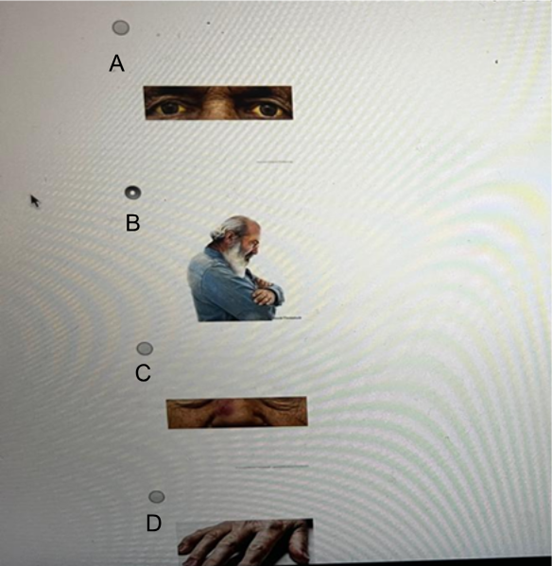A nurse at a provider's office is collecting physical data from an older adult client. Which of the following images should the nurse identify as an example of an expected age-related change?

A
B
C
D
The Correct Answer is D
A. Close-up of eyes with yellow sclera: Could indicate jaundice or liver dysfunction, which is not an expected part of aging and requires further evaluation.
B. Older adult man with a rounded back and head tilted forward: Suggests kyphosis, which can occur with aging but is usually linked to osteoporosis or vertebral fractures, not considered an inevitable, expected change.
C. Close-up of nose with a reddish-purple spot (possible bruise): Might result from trauma, coagulopathy, or medication side effects like anticoagulants, not a routine age-related change.
D. Hands with prominent veins, thin skin, and wrinkles: Thinning skin due to decreased subcutaneous fat. Wrinkles from reduced skin elasticity. Prominent veins due to loss of skin turgor and connective tissue. These are all normal physical findings in older adults.
Nursing Test Bank
Naxlex Comprehensive Predictor Exams
Related Questions
Correct Answer is C
Explanation
A. "Why do you think they're not eating?”: This question may come across as confrontational or accusatory, which can make the child feel defensive. It does not foster open communication or help the nurse gather specific, objective information.
B. "They may need a feeding tube.": Introducing a feeding tube early in the discussion can cause unnecessary alarm. It is a significant intervention that should only be considered after a thorough assessment and evaluation by the provider.
C. "Tell me more about what happens at mealtime.": This open-ended, nonjudgmental question encourages the child to provide detailed information about the client's eating habits, environment, and possible stressors, helping the nurse assess the situation more effectively.
D. "I'm sure it's nothing serious and their appetite will return soon.": This response is dismissive and minimizes the child’s concern. It may hinder further communication and delay identifying potential underlying issues with the client's nutrition.
Correct Answer is B
Explanation
A. Apply a heating pad to the client's neck: Direct application of heat to the skin, especially in localized areas like the neck, can cause rapid vasodilation, leading to a dangerous drop in blood pressure and potential cardiac complications. It also increases the risk of burns on cold-numbed skin.
B. Provide the client with dry clothing: Removing wet clothing and replacing it with dry garments is the first priority in managing hypothermia. Wet clothes accelerate heat loss through conduction and evaporation. Stopping further heat loss is essential before attempting active rewarming.
C. Offer the client a warm beverage: While offering warm fluids can help increase core temperature and provide comfort, it is not the first priority. This intervention is more appropriate after ensuring the client is dry and wrapped in warm coverings.
D. Wrap the client in warm blankets: Wrapping the client in warm blankets is a critical intervention for passive external rewarming. However, it comes after the initial step of removing wet clothes to prevent ongoing heat loss. Blankets are most effective once the source of heat loss has been eliminated.
Whether you are a student looking to ace your exams or a practicing nurse seeking to enhance your expertise , our nursing education contents will empower you with the confidence and competence to make a difference in the lives of patients and become a respected leader in the healthcare field.
Visit Naxlex, invest in your future and unlock endless possibilities with our unparalleled nursing education contents today
Report Wrong Answer on the Current Question
Do you disagree with the answer? If yes, what is your expected answer? Explain.
Kindly be descriptive with the issue you are facing.
